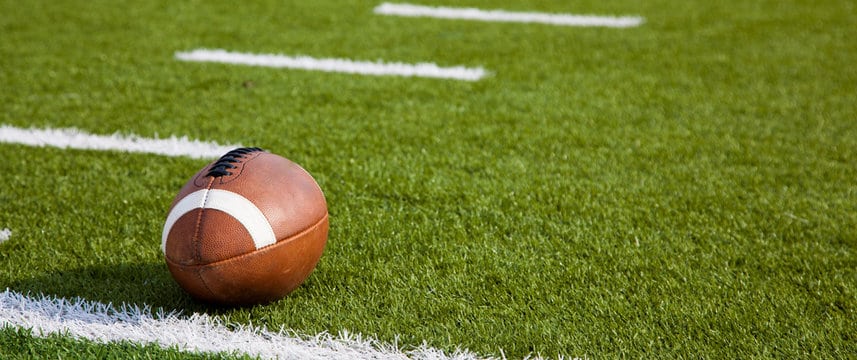How to Throw A Football: Quarterback Guide

If you’re reading this post, I’m guessing you’re interested in learning how to throw a football, or maybe you’re just looking to improve your technique. Whatever your motivation, I’m here to help. As a former college quarterback and current coach, I’ve spent countless hours perfecting my throwing technique and teaching others how to do the same. In this post, I’ll be sharing my tips and tricks for throwing a football like a pro.
Before we dive into the nitty-gritty of throwing technique, let’s talk about the importance of having a good throwing motion. As a quarterback, your ability to throw accurately and with power can be the difference between winning and losing. A good throwing motion not only helps you complete passes but also reduces the risk of injury. By using proper technique, you’ll be putting less strain on your throwing arm, throwing shoulder, and back, which can help you avoid common quarterback injuries like rotator cuff tears and shoulder impingement.
Now, let’s get into the steps to follow to improve your throwing motion:
Fundamentally speaking, I have four major pillars on how to throw a football consistently.
How to throw a football.
C-Bicep-Pop-Follow through
C (Grip)
C ultimately is your grip on the football.
While holding a football, your throwing hand should form a C around the football. You should hold the ball with your fingertips, not your palm, and make sure the laces are facing up. Your non throwing hand should is used as support.
Here is a general guide on how to grip the ball:
Your pink and ring finger should be on the laces, while your middle finger and index fingers grip the front of the ball. Finally, your thumb should be placed on the underside of the ball, opposite your fingers.
Disclaimer: there are different ways to hold a football, so find one that’s comfortable for you.
For example, I only have my ring finger on the lace with my middle finger on the seam going along the white paint. My pinky finger rests below the laces while my index finger is fully extended.
By holding the ball in this way, you’ll be able to get a tight spiral when you throw, which will help the ball fly straighter and more accurately.
Common mistakes:
There are a few common mistakes that people make when gripping a football. These mistakes can lead to a poor grip, which can then lead to a number of other issues when throwing the ball. Here are a few common mistakes to look out for:
- Gripping the ball with the palm
- Not using the fingertips
- Not keeping the ball close to the body
- Gripping the ball too tightly
- Gripping the ball with the palm. One of the most common mistakes is to grip the ball with the palm of the hand. This can make it difficult to get a good grip on the ball and control the throw.
- Not using the fingertips. Another common mistake is to not use the fingertips when gripping the ball. This can lead to a weaker grip and make it harder to throw accurately.
- Not keeping the ball close to the body. When gripping the ball, it’s important to keep it close to the body. Holding the ball too far away can lead to a weak grip and make it harder to throw accurately.
- Gripping the ball too tightly. Gripping the ball too tightly can also be a problem. This can cause the muscles in your throwing hand and arm to tense up, which can lead to a less fluid throwing motion and reduce accuracy.
To avoid these common mistakes, make sure to grip the ball with your fingertips, keeping it close to your body and holding it with the correct hand. Practice your grip regularly to build strength and improve your accuracy.
Over time, you’ll develop a strong and consistent grip that will help you throw the ball more accurately and with more power.

Bicep (Wind-up)
Picture this, bring the ball towards your bicep, this is your wind up.
Start by bringing the ball back behind your head, using a smooth, controlled motion. Your elbow should be nice and compact and no further than a 90-degree angle.
The wind-up helps you generate more power and momentum for your throw.
Common mistakes:
There are a few common mistakes that people make when winding up. These mistakes can impact your motion and lead to inaccurate passes. Here a few common mistakes to look out for:
- Uncontrolled motion
- Dipping the ball too low
- Uncontrolled motion. Having a wind-up that is not smooth and natural will have the same result when you release the ball.
- Dipping the ball too low. This one is extremely common when your trying to throw deep. Dipping the ball elongates your motion and takes extra time in your motion. Another issue is you run the risk of fumbling the ball too.
Pop (Release)
Bring the ball forward, release it by flicking your wrist and snapping your fingers. As your throwing arm comes forward you really want pop/explode the ball through.
As your arm comes forward you should take a slight step forward.
This will help you get a tight spiral and throw the ball accurately. As you release the ball, make sure to keep your throwing hand pointed towards your target, and don’t let your arm drop too low.

Follow-through
After releasing the ball, follow through with your throwing arm forward, extending it fully towards your target.
Your non throwing hand should also come across your body, helping to maintain your balance. The ball should come off your fingers with your index finger being the last one to touch the ball.
Your follow-through should be smooth and controlled, not jerky or abrupt.
Stance
Next, it’s important to have a good throwing stance.
Your feet should be shoulder-width apart, with your non-throwing foot slightly in front of your throwing foot. This will help you generate more power and maintain your balance as you throw.
Your weight should be evenly distributed between your two feet with knees slightly bent. Finally, you should keep your shoulders and hips squared to your target.
Practice Drills
Now that you know the basic steps to throwing a football correctly, it’s time to start practicing. Here are some drills you can try:
- Target Practice
- Footwork Drills
- Partner Drills
- Video Analysis
Target Practice
Set up a target, such as a tire or a cone, and practice throwing the ball at it from different distances and angles. This will help you improve your accuracy and power.
Footwork Drills
Practice your footwork by moving around in the pocket, stepping up and back as you throw, and pivoting to different angles. This will help you stay balanced and generate more power when you throw.
Partner Drills
Practice throwing with a partner, focusing on your timing and accuracy. Start with short passes and gradually increase the distance as you improve.
Video Analysis
Use video analysis to review your throwing technique and identify areas for improvement. This can be especially helpful if you’re working on specific aspects of your throwing motion, such as footwork or release point.
Consistency and Progression
Finally, it’s important to be consistent with your practice and track your progress over time.
Don’t get discouraged if you don’t see immediate results – improving your throwing technique takes time and effort.
Set specific goals for yourself, such as increasing your accuracy or improving your footwork, and track your progress towards these goals.
As you become more comfortable with your throwing motion, don’t be afraid to challenge yourself by trying new techniques or practicing in different environments.
For example, you might try throwing while on the move, or practice throwing in different weather conditions.
By varying your practice routine and pushing yourself to improve, you’ll become a more well-rounded and confident quarterback.
Frequently Asked Questions (FAQ)
Is throwing a football easy?
Throwing a football may seem easy, but mastering the skill and becoming proficient at it can take time and practice. While some people may naturally have better throwing mechanics or athleticism, it still requires deliberate effort to develop accuracy, power, and consistency in your throws. Here are a few factors to consider:
Technique
Throwing a football with proper technique involves a combination of grip, stance, footwork, arm motion, and follow-through. Learning and refining these mechanics can take time and practice. It requires coordination, muscle memory, and understanding the intricacies of the throwing motion.
Accuracy
Throwing a football accurately involves not only hitting your intended target but also accounting for distance, angle, and the movement of both the receiver and the defenders. This requires spatial awareness, timing, and the ability to adjust your throw in real-time.
Power and Distance
Throwing a football with sufficient power and distance requires strength in the right muscles, proper body mechanics, and an understanding of how to transfer force from your lower body through your core and into your throwing arm. Developing arm strength and the ability to generate power takes time and consistent training.
Decision-Making:
As a quarterback, you need to make split-second decisions on where and when to throw the ball. This includes reading the defense, identifying open receivers, and making accurate judgments under pressure. Decision-making skills improve with experience and knowledge of the game.
While it may take time and effort to become a skilled thrower, the good news is that anyone can improve their throwing ability with practice and dedication. Working on your technique, regularly engaging in drills and exercises, seeking feedback, and playing in real-game situations can all contribute to the development of your throwing skills. Remember, consistent practice and a positive mindset are key to becoming a proficient thrower.
Is it hard to throw a football?
The difficulty of throwing a football can vary depending on a person’s individual skill level, experience, and natural abilities. For some individuals, throwing a football may come naturally, while for others, it may require more time and practice to develop the necessary skills. Here are a few factors that can influence the perceived difficulty:
Technique
Throwing a football with proper technique can be challenging, especially if you’re new to the sport or haven’t had much practice. Mastering the correct grip, stance, footwork, and arm motion requires coordination, muscle memory, and attention to detail.
Coordination and Timing
Throwing a football involves coordinating multiple body movements simultaneously. It requires syncing the movements of your feet, hips, shoulders, and arm to generate power and accuracy. Timing is crucial, as you need to release the ball at the right moment to hit your target.
Skill Development
Developing the necessary skills to throw a football effectively takes time and consistent effort. It involves improving arm strength, accuracy, and decision-making abilities. Progressing from short to longer throws, adjusting to different types of passes (e.g., short, medium, long), and adapting to game scenarios can add complexity to the learning process.
Game Situations.
Throwing a football becomes more challenging in game situations where there may be pressure from the defense, limited time to make decisions, and the need to read and react quickly. The ability to adapt and perform under such circumstances can contribute to the perceived difficulty.
While throwing a football can be initially challenging, with practice and dedication, most individuals can improve their throwing skills. It’s important to remember that everyone progresses at their own pace, and consistent effort, patience, and a growth mindset can help overcome any initial difficulties. Seeking guidance from coaches or experienced players, engaging in drills and practice routines, and gradually increasing the level of difficulty can all contribute to mastering the art of throwing a football.
Related Articles
Wrap-up.
In conclusion, how to throw a football like a pro takes practice, patience, and dedication. By following these steps and practicing consistently, you can improve your throwing technique and become a more effective quarterback. Remember to focus on your grip, stance, throwing motion, and follow-through, and don’t be afraid to challenge yourself with new drills and techniques. With hard work and perseverance, you can take your throwing skills to the next level. Good luck!